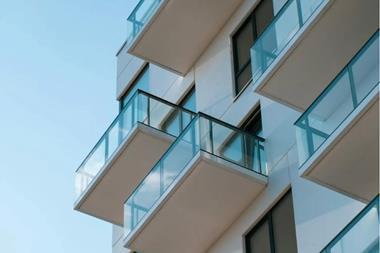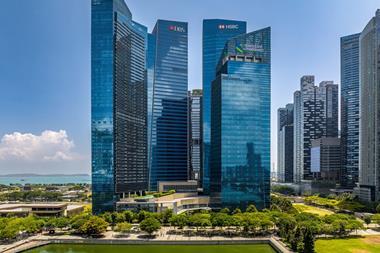Investors and asset managers should prioritise long-term energy efficiency upgrades that align with renovations, consider EPC updates and collaborate with tenants to meet energy reduction goals, writes Elizabeth Greenhill
Driven by the climate emergency and investor demand, the real estate industry is undergoing a seismic shift, placing sustainability and energy efficiency at the core of asset management and investment strategies.
With tightening regulations and increasing focus on environmental, social, and governance (ESG) criteria, stakeholders must adapt to maintain and enhance property value.

Costing Energy Efficiency Improvements in Existing Commercial Property – the latest research from the Investment Property Forum, led by Currie & Brown – provides vital insights into the costs associated with energy efficiency enhancements, highlighting the urgent need for action in improving the energy performance of commercial assets.
Importance of energy efficiency in the context of regulatory and market pressure
Energy efficiency is no longer a peripheral concern for commercial landlords; it is a core component of asset value and marketability.
The UK government’s commitment to achieve net zero carbon by 2050, combined with the Minimum Energy Efficiency Standards (MEES), places significant obligations on property owners.
Regulations enforced in since April 2023, make it illegal to lease commercial properties with an Energy Performance Certificate (EPC) rating below E without a registered valid exemption, and the standards are set to tighten further by 2030.
Non-compliance impacts income streams and asset value, emphasising the importance of energy-efficient buildings, which offer operational cost savings, tenant satisfaction, and market advantages. Tenants increasingly prefer buildings that support their own sustainability goals, making energy-efficient properties more attractive.
Properties with good ESG credentials are perceived as lower risk and more resilient, attracting a growing pool of institutional investors. Additionally, property values are increasingly exposed to climate risk, and climate risk equates to investment risk.
The research
The research examines seven distinct building typologies across the retail, industrial, office, and residential sectors. It aims to provide actionable insights into improving energy efficiency by identifying potential options, estimating costs, and understanding how enhancements impact EPC ratings.
Additionally, given the limitations of EPC ratings at predicting actual energy efficiency, the research explores the measures in the context of the net zero carbon pathways set by the Carbon Risk Real Estate Monitor (CRREM) tool for energy and carbon intensity.
The CRREM tool provides Paris-aligned decarbonisation and energy reduction pathways tailored to each country and building type. These pathways serve as benchmarks for risk management, reporting, and disclosure, helping asset managers and investors align their properties with global climate goals.
Energy efficiency measures and costs
A range of discrete asset energy improvement measures were modelled, as applicable, by building typology, including: lighting; ventilation (air handling units, fan coil units, demand-controlled ventilation, and mechanical ventilation with heat recovery); air source heat pumps; direct electric heating; photovoltaics; wastewater heat recovery; and fabric improvements.
Packages of improvements are required to achieve significant improvements in EPC ratings. For most building typologies studied, a combination package of three improvement measures - lighting, ventilation and heat pumps will meet the requirement of EPC ‘B’. In the retail unit, logistics warehouse and student accommodation typologies, the heat pump or direct electric heating package alone will also meet EPC ‘B’. Of course, these are typology scenarios and actual improvements are dependent on the age and condition of the existing building.
For instance, transforming a 1970s, five-storey, air-conditioned office from EPC ‘G’ to ‘B’ would involve installing LED lighting and new controls, upgrading air handling units and fan coils, and adopting air source heat pumps. This package would likely align the building with the CRREM carbon intensity pathway and remain below the target intensity through to 2050.
If these works were completed as part of planned asset improvements the capital cost could be in the region of £220 per square meter. These costs would be over 2.5 times higher if works were carried out in an unplanned energy upgrade scenario.
Limitations of EPC ratings
Despite their utility, EPC ratings have notable limitations in predicting actual energy consumption and they do not account for actual energy use variations, occupancy patterns, or building management practices. A study by the Better Buildings Partnership found a weak correlation between EPC ratings and actual energy intensities in office buildings.
Taking action
When considering energy efficiency upgrades, investors and asset managers should adopt the following recommendations:
- Long-term thinking – take a long-term approach to decision making for energy efficiency improvements to buildings and portfolios.
- Align with future building works – thorough evaluation should uncover every chance to improve the asset’s energy performance, ensuring compliance with current regulations and positioning it for future policy shifts. Energy efficiency must be prioritised in building refurbishment plans.
- For MEES compliance, focus on updating EPCs – be aware of the risk of inaccurate EPCs and give precedence to getting updated EPCs for properties that could be at risk. The change in EPC modelling method that took place in June 2022 with the updated building regulations will result in a change in EPC rating for most buildings when reassessed. In relation to new tenancies or renewals, assess current and future risk.
- Work with tenants on meeting CRREM pathways – to drive down both regulated and unregulated energy consumption in the building. For most existing assets, meeting the CRREM pathways (energy and carbon intensity) will require active energy management alongside improvement measures and property management interventions.
The bottom line
As regulatory landscapes shift and market trends prioritise sustainability, optimising the energy performance of commercial properties becomes paramount.
Integrating energy efficiency upgrades and heat decarbonisation during the next refurbishment cycle offers a strategic and cost-effective approach to achieving compliance with evolving standards and navigating pathways towards carbon reduction.
Asset managers should be looking to identify priority buildings, review actual building energy performance, develop a costed improvement strategy and deliver it.
To read the latest IPE Real Assets magazine click here.


















